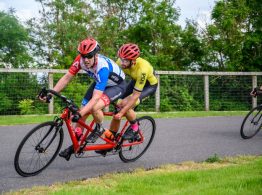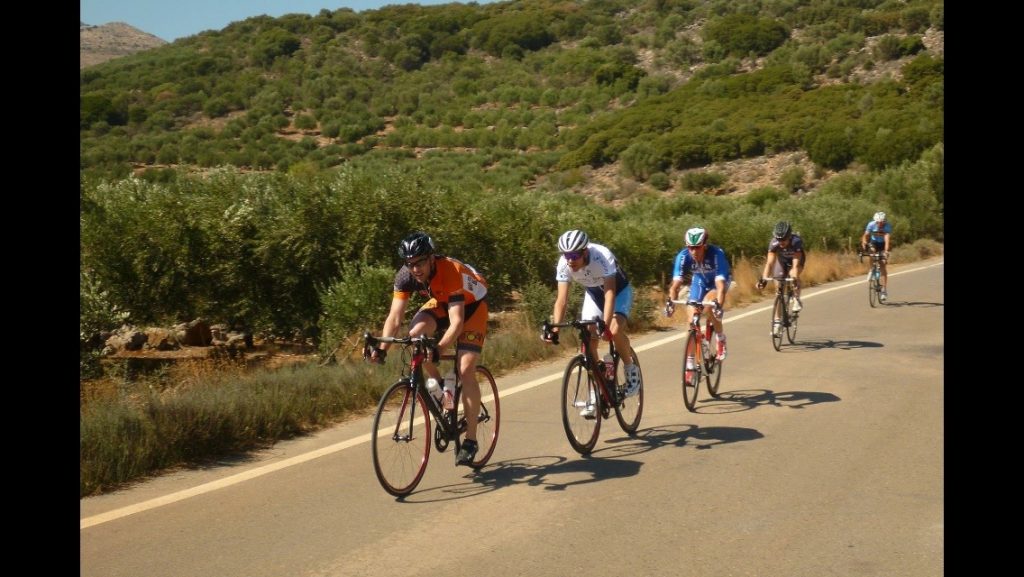Effective Training for Busy Professionals – Part 2
In part one we covered the importance of getting the basics right over fancy gizmos, gadgets and supplements. We covered the first 2 Balance and Patience. Today we will discuss the importance of getting the intensity control, frequency and consistency right; and how to do it!
Frequency and Consistency
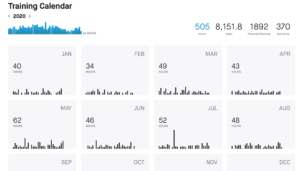
‘Slowly building consistency over time’
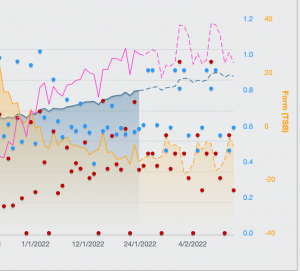
Frequency and consistency build your volume. All combined together these are the most powerful drivers of endurance performance.
At its core, what you are trying to do by training is encourage your body to adapt and become better at cycling…simple really! However, it does get a little more complicated as there is more that one way to do this.
That’s why getting the fundamentals in place will give you the best chance of success. Frequency, consistency and volume are your biggest driver. Endurance adaptations including:
- Increasing capillaries – More oxygen for working muscles
- Increasing Mitochondria – Increased energy for the muscles
- Improve Cardiovascular efficiency – Increase blood flow to working muscles
- Increased Blood Plasma – more blood volume improves VO2
- Improved metabolic efficiency – Able to convert more fuel into work
This is just the tip of the iceberg really…there are so many changes that improve performance it would be an epic book to cover them all! Though this can get very complicated, it is actually very simple to illicit these improvements…get on the bike regularly, consistently and do it week in week out, month in month out, year in year out. That’s why I sploke of patience previously.
The good news is you don’t have to wait years for your fitness…these changes happen within weeks and months of beginning training, but with good training the improvements will continue gradually for years.
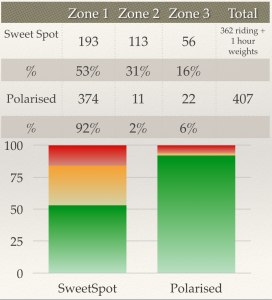
Good Intensity Control
Lots of easy training…a sprinkling of high intensity
My Intensity Distribution
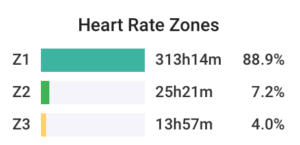
This topic has possibly been the most hotly debated over recent years. It relates to the time you spend training in different zones.
The temptation when you have limited time to train is that you train really hard all the time. This seems logical, but it is so easy to go over-board and your training will quickly plateau if you go down this route. This is probably the biggest mistake a time-crunched athlete can make.
Endurance training should emphasise training at lower intensities for the vast majority of the time. It depends on your training volume, but over 80% of your training should be easy (see picture on the left) and the higher the volume, the higher this easy training percentage will go.
The first thing you need to know is your training zones. The simplest system to use is the 3 zone, heart rate-based model I use with my athletes:
- Zone 1 = <78% MHR (maximum heart rate)
- Zone 2 = 78-86% MHR
- Zone 3 = >86% MHR
These percentages are just a start and may need adjusting slightly for the individual. Obvuosly, you need to know your max heart rate. I use the MHR you’ve seen on your bike. If you aren’t 100% sure a beat or 2 either way won’t make a massive difference and if in doubt, slightly lower is better.
If you are disciplined at keeping easy rides in Z1, then you can really get the benefit from working hard in your Z2 and Z3 rides. This gives you the best mix for endurance gains.
Summary
All of the points above feed off each other. If you are patient and keep your life and training in balance you will build consistency and find the frequency of training that fits into your life without overloading you and causing breaks in training.
Complimenting these with good intensity control is vital. If you keep disciplined with your intensity you will avoid excessive nervous system stress that can lead to burnout and low motivation even in those with low training volumes.
I’ve written a short case study for one of my athletes on a time-crunched programme of 4-5 hours; his FTP went from 161 to 223 over the winter base period 2021-22.
Read the Time-Crunched Case Study here
